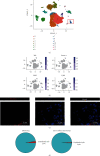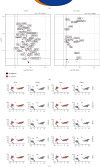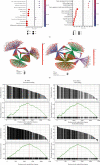Transcriptome Comparison of Brain and Kidney Endothelial Cells in Homeostasis
- PMID: 35132377
- PMCID: PMC8817106
- DOI: 10.1155/2022/5239255
Transcriptome Comparison of Brain and Kidney Endothelial Cells in Homeostasis
Retraction in
-
Retracted: Transcriptome Comparison of Brain and Kidney Endothelial Cells in Homeostasis.Biomed Res Int. 2024 Mar 20;2024:9784107. doi: 10.1155/2024/9784107. eCollection 2024. Biomed Res Int. 2024. PMID: 38550087 Free PMC article.
Abstract
Endothelial cells are heterogeneous, stemming from multiple organs, but there is still little known about the connection between the brain and kidney endothelial cells, especially in homeostasis. In this study, scRNA-seq results were obtained to compare genetic profiles and biological features of tissue-specific endothelial cells. On this basis, seven endothelial cell subpopulations were identified, two of which were upregulated genes in pathways related to stroke and/or depression, as characterized by neuroinflammation. This study revealed the similarities and distinctions between brain and kidney endothelial cells, providing baseline information needed to fully understand the relationship between renal diseases and neuroinflammation, such as stroke and depression.
Copyright © 2022 Xiaohua Huang et al.
Conflict of interest statement
The authors declare that this research was conducted without any commercial or financial relationships that could be construed as potential conflicts of interest.
Figures




Similar articles
-
Creation of a Single Cell RNASeq Meta-Atlas to Define Human Liver Immune Homeostasis.Front Immunol. 2021 Jul 16;12:679521. doi: 10.3389/fimmu.2021.679521. eCollection 2021. Front Immunol. 2021. PMID: 34335581 Free PMC article.
-
Single-Cell Studies of Intestinal Stem Cell Heterogeneity During Homeostasis and Regeneration.Methods Mol Biol. 2020;2171:155-167. doi: 10.1007/978-1-0716-0747-3_9. Methods Mol Biol. 2020. PMID: 32705640
-
Role of HRTPT in kidney proximal epithelial cell regeneration: Integrative differential expression and pathway analyses using microarray and scRNA-seq.J Cell Mol Med. 2021 Nov;25(22):10466-10479. doi: 10.1111/jcmm.16976. Epub 2021 Oct 9. J Cell Mol Med. 2021. PMID: 34626063 Free PMC article.
-
Cellular heterogeneity and stem cells of vascular endothelial cells in blood vessel formation and homeostasis: Insights from single-cell RNA sequencing.Front Cell Dev Biol. 2023 Mar 21;11:1146399. doi: 10.3389/fcell.2023.1146399. eCollection 2023. Front Cell Dev Biol. 2023. PMID: 37025170 Free PMC article. Review.
-
New insights into the dynamic regulation of water and acid-base balance by renal epithelial cells.Am J Physiol Cell Physiol. 2012 May 15;302(10):C1421-33. doi: 10.1152/ajpcell.00085.2012. Epub 2012 Mar 28. Am J Physiol Cell Physiol. 2012. PMID: 22460710 Free PMC article. Review.
Cited by
-
Endothelial Cells and the Blood-Brain Barrier: Critical Determinants of Ineffective Reperfusion in Stroke.Eur J Neurosci. 2025 Feb;61(3):e16663. doi: 10.1111/ejn.16663. Eur J Neurosci. 2025. PMID: 39935212 Free PMC article. Review.
-
Retracted: Transcriptome Comparison of Brain and Kidney Endothelial Cells in Homeostasis.Biomed Res Int. 2024 Mar 20;2024:9784107. doi: 10.1155/2024/9784107. eCollection 2024. Biomed Res Int. 2024. PMID: 38550087 Free PMC article.
References
-
- Shi H., Feng G., Wang Z., et al. Relationships between depressive symptoms and endothelial function among outpatients of a general hospital in China. Medical Science Monitor: International Medical Journal of Experimental and Clinical Research . 2015;21:1812–1819. doi: 10.12659/MSM.893531. - DOI - PMC - PubMed
-
- Lopez-Vilchez I., Diaz-Ricart M., Navarro V., et al. Endothelial damage in major depression patients is modulated by SSRI treatment, as demonstrated by circulating biomarkers and an in vitro cell model. Translational Psychiatry . 2016;6(9, article e886) doi: 10.1038/tp.2016.156. - DOI - PMC - PubMed
Publication types
MeSH terms
LinkOut - more resources
Full Text Sources

